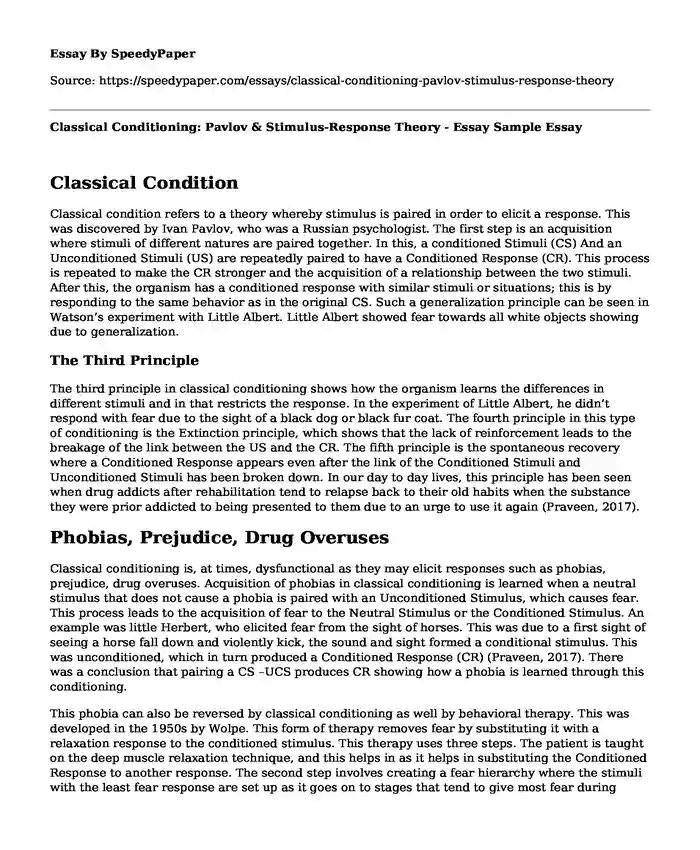
| Type of paper: | Essay |
| Categories: | Psychology Biology Science Behavior |
| Pages: | 3 |
| Wordcount: | 677 words |
Classical Condition
Classical condition refers to a theory whereby stimulus is paired in order to elicit a response. This was discovered by Ivan Pavlov, who was a Russian psychologist. The first step is an acquisition where stimuli of different natures are paired together. In this, a conditioned Stimuli (CS) And an Unconditioned Stimuli (US) are repeatedly paired to have a Conditioned Response (CR). This process is repeated to make the CR stronger and the acquisition of a relationship between the two stimuli. After this, the organism has a conditioned response with similar stimuli or situations; this is by responding to the same behavior as in the original CS. Such a generalization principle can be seen in Watson’s experiment with Little Albert. Little Albert showed fear towards all white objects showing due to generalization.
The Third Principle
The third principle in classical conditioning shows how the organism learns the differences in different stimuli and in that restricts the response. In the experiment of Little Albert, he didn’t respond with fear due to the sight of a black dog or black fur coat. The fourth principle in this type of conditioning is the Extinction principle, which shows that the lack of reinforcement leads to the breakage of the link between the US and the CR. The fifth principle is the spontaneous recovery where a Conditioned Response appears even after the link of the Conditioned Stimuli and Unconditioned Stimuli has been broken down. In our day to day lives, this principle has been seen when drug addicts after rehabilitation tend to relapse back to their old habits when the substance they were prior addicted to being presented to them due to an urge to use it again (Praveen, 2017).
Phobias, Prejudice, Drug Overuses
Classical conditioning is, at times, dysfunctional as they may elicit responses such as phobias, prejudice, drug overuses. Acquisition of phobias in classical conditioning is learned when a neutral stimulus that does not cause a phobia is paired with an Unconditioned Stimulus, which causes fear. This process leads to the acquisition of fear to the Neutral Stimulus or the Conditioned Stimulus. An example was little Herbert, who elicited fear from the sight of horses. This was due to a first sight of seeing a horse fall down and violently kick, the sound and sight formed a conditional stimulus. This was unconditioned, which in turn produced a Conditioned Response (CR) (Praveen, 2017). There was a conclusion that pairing a CS –UCS produces CR showing how a phobia is learned through this conditioning.
This phobia can also be reversed by classical conditioning as well by behavioral therapy. This was developed in the 1950s by Wolpe. This form of therapy removes fear by substituting it with a relaxation response to the conditioned stimulus. This therapy uses three steps. The patient is taught on the deep muscle relaxation technique, and this helps in as it helps in substituting the Conditioned Response to another response. The second step involves creating a fear hierarchy where the stimuli with the least fear response are set up as it goes on to stages that tend to give most fear during therapy. This can be done using images. In the third step, the patient works up the hierarchy fear again practicing the relaxation techniques as they go to the highest level of fears. This is done repeatedly until there is no more fear evoked due to the Conditioned Stimuli, and a different Conditioned Response is learned in the process (Saul, 2015). This process in which this behavioral therapy bases its principle on classical conditional is known as systematic desensitization. However, this therapy, at times, faces challenges due to the relapsing of the Conditional Response (CR) to the prior response due to the principle of spontaneous recovery.
References
Praveen Shrestha, (2017). Principles of Classical Conditioning. Psyche study. Retrieved from https://www.psychestudy.com/behavioral/learning-memory/classical-conditioning/principles.
Praveen Shrestha, (2017). Classical Conditioning and Phobias. Psychstudy. https://www.psychestudy.com/behavioral/learning-memory/classical-conditioning/phobias.
Sauk McLeod, (2015). Systematic Desensitization. Simply Psychology. Retrieved from https://www.simplypsychology.org/Systematic-Desensitisation.html
Cite this page
Classical Conditioning: Pavlov & Stimulus-Response Theory - Essay Sample. (2023, Sep 14). Retrieved from https://speedypaper.net/essays/classical-conditioning-pavlov-stimulus-response-theory
Request Removal
If you are the original author of this essay and no longer wish to have it published on the SpeedyPaper website, please click below to request its removal:
- Gothic Architecture Characteristics
- Social Work
- Learning Journal Entry, Free Essay
- Essay Sample: Fictional Story of the Evolution of White Hares
- Inconsistencies and Tensions of Marxism and Communism, Essay Example
- Echinacea - Free Essay Sample
- Paper Example. Aircraft Stability and Control Parameters
Popular categories




